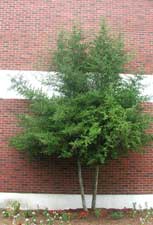Resource Library
Plant of the Week: Yaupon Holly
The University of Arkansas System Division of Agriculture does not promote, support or recommend plants featured in "Plant of the Week." Please consult your local Extension office for plants suitable for your region.
Plant of the Week
Yaupon Holly
Latin: Ilex vomitoria

I like all plants, but I especially like those that have a good backstory. With a name like Ilex vomitoria¸ how could the yaupon holly that is so commonly used in our gardens and landscapes not have a good story to tell?
Yaupon holly is a small evergreen tree growing 15-to-20 feet tall with gray, arm-sized trunks and many branched, twiggy limbs that give plants a stiff, picturesque habit. Short shoots form on older plants that have leaves of diminishing size to the tip, giving these side branches an almost thorn-like look.
The evergreen leaves are bright green in the summer but take on a grayish cast in winter. They are up to one and one-half inches long, but without prickles found in many of our other hollies. Like all hollies, these plants are dioecious, with female plants producing small pea-sized, fleshy, bright red berries during the winter months.
Yaupons are native to the coastal lowlands from Virginia to Texas, but are found inland in all adjacent states as far west as Oklahoma, possibly carried there by Native Americans during pre-Columbian days. Plants are often found growing in winter-wet, summer-dry locations, often in areas receiving coastal salt sprays.
Yaupon holly was first introduced to Europe in 1700, an early date for a plant we now think of as an ornamental. Amongst the native tribes of the southeastern states this tree was no ornamental, but an important plant used in ceremonial and social events. Yaupon holly, it turns out, is the only holly in North America with significant levels of caffeine. (A related South American holly, I. paraguariensis, is the source of a tea sold in markets there.)
Several reports of the ritualistic use of "black drink," as the European traders called it, appeared in the writings of 18th century authors. James Adair (1709-1783) lived amongst the Cherokees and Chickasaw in the Carolinas for 40 years during middle years of the 18th century, earning his living primarily trading for deer skin pelts. In his 1775 book, History of American Indians, he tried to prove that the American Indians were the Lost Tribes of Israel mentioned in the Bible.
Adair called the called the drink, prepared from roasted leaves and young stems, "yopon" and "cussena," the names used by the native tribes among whom he lived. Roasting, just as is done with coffee beans, makes caffeine soluble. The drink was served communally, with only men allowed to drink the brew, and then only in a strictly hierarchical arrangement. Visitors were served first, followed by tribe members in order of descending seniority.
Though visiting Europeans were offered the drink with no apparent ill effects (its caffeine content is thought to be from 1 to 3 times as strong as a cup of java served today), the Indians often vomited after drinking copious amounts of the brew. This became the scientific epitaph when William Aiton published a description of the plants growing at Kew Gardens in London in 1789. Once a perfectly good drink becomes associated with vomiting, it’s not likely to catch on in commerce. When the southeastern tribes were forced to leave their native homelands for Indian Territory in the 1820s and 30s, the ceremonial use of black tea seems to have stopped.
Yaupon hollies are well-suited plants for the garden and landscape. Plants are cold-hardy from zones 6b through 10, where standard trees are often used as small specimen trees near patios or entryways. A weeping form is also widely grown and makes a striking specimen. A number of dwarf yaupon holly clones have been propagated to serve the role as "green meatballs" - little round shrubs for hedging or use in foundation plantings. Yaupons have good drought tolerance; they grow in a wide variety of soil types and are not commonly bothered by pests. They do best when grown in full sun.
By: Gerald Klingaman, retired
Extension Horticulturist - Ornamentals
Extension News - February 26, 2010
The University of Arkansas System Division of Agriculture does not maintain lists of retail outlets where these plants can be purchased. Please check your local nursery or other retail outlets to ask about the availability of these plants for your growing area.